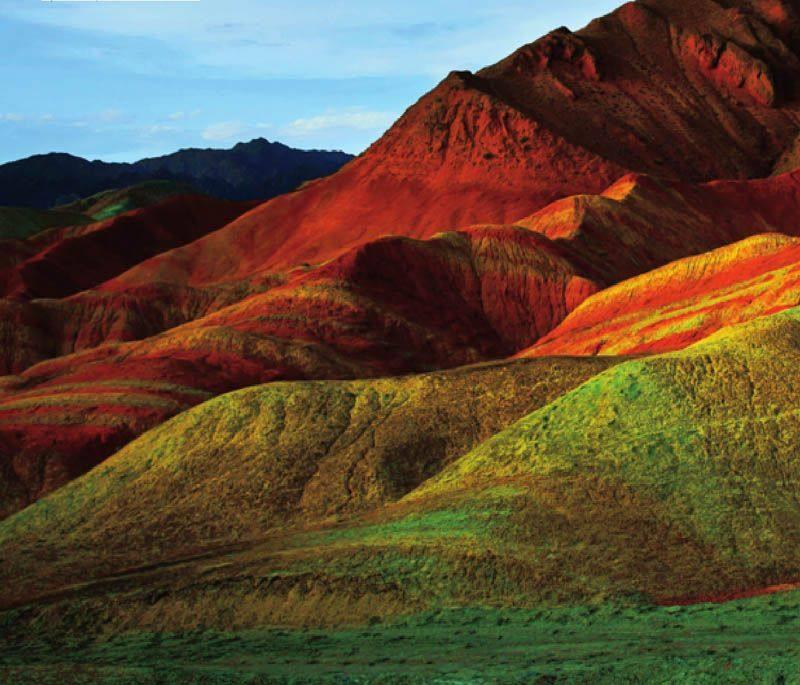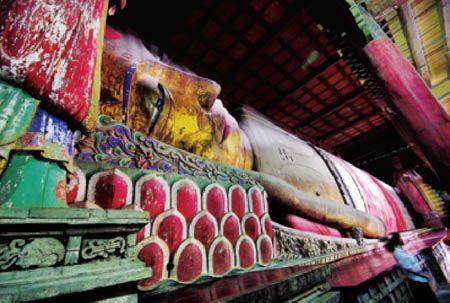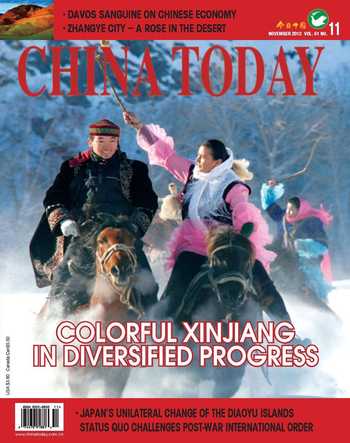Zhangye City – A Rose in the Desert
LI GUOWEN


ZHANGYE is an ancient city where people of different ethnic groups and divergent cultures have converged during its long history. It lies in the middle of the Hexi Corridor in Gansu Province and is located on the Old Silk Road along which merchants from the East and the West traveled for centuries, toting their wares and their cultures. The city of Campichu, where Marco Polo (1254-1324) claimed to have spent a year, has been identified as Zhangye, testament to the citys position as a meeting point of the ancient world.
The city has an average precipitation of just 130 mm, but, on the way from Lanzhou to Zhangye, we passed lush fields of a type seldom seen in this parched province, or even in Chinas north in general. This is Zhangyes oasis and why the city is home to two national nature reserves. After driving through its verdant landscape, we arrived in Zhangye at dusk, dazed by this anachronistic scenery. We checked in to our hotel, ate our fill of local specialties, and planned the days ahead.
The Giant Buddha Temple
Early next morning we visited the Giant Buddha Temple, where, according to our guide, Kublai Khan (1215-1294), founder of the Yuan Dynasty, was born. Marco Polo often visited the temple during his stay in the city. It is best known, however, for housing Chinas largest reclining Buddha statue.
The statue shows the Sakyamuni lying on his side in the Nirvana position. The Buddha, in the center of the hall, is 34.5 meters long and his shoulders are 7.5 meters across. His stylistic elongated ears stretch four meters and could accommodate eight people sitting side by side. A person could lie happily on his humongous middle finger. His feet would need shoes a whopping 5.2 meters long.
To build a Buddha of such magnitude, craftsmen had to bring together techniques from architecture, clay sculpture and other arts. A huge frame of wood, bigger than a large house, first had to be constructed. Workers then nailed boards to the frame and covered it with claywhich they molded into the fine features of the Buddha. The last step was to decorate the statue with colorful pigments. The result is something that is simply awe-inspiring.
We eventually tore our eyes from the imposing figure that dominates the hall, and turned to inspect the murals that adorn its walls. One depicts the story of Chinese classic Journey to the West. It shows Pigsy (a disciple of Monk Xuanzang) carrying luggage and fighting demons bravely, taking difficult tasks and hardships without complaints. The characterization contradicts traditional depictions of the Pigsy as a lazy and careless character with a voracious appetite. This departure from tradition may be attributable to the local belief that Zhangyes Gaolaozhuang Village was where Pigsy was said to have been married, so locals have a fondness for the character, as well as a little pride.
The temple is also home to some very important Buddhist scriptures written with gold dust. They can be found in the Buddhist Scriptures Hall, where rows of red wooden cabinets are filled with the precious writings. It is thought that part of the scriptures, beautifully written and laid out, was copied by a eunuch during the Ming Dynasty, and that their survival into the present day is down to the dedication of the local people.
Over the past six centures, the temple has gone through the test of wars. Locals have done all they could to protect those scriptures. According to our guide, when the Japanese bombed Lanzhou in 1937 Chinas Kuomintang troops used the temple for operations. To avoid any risk of damaging the scriptures the president of the Buddhist Association of Zhangye and the then abbot Miaoxian of the temple together arranged the transfer of the scriptures deep into the Qilian Mountains. Later they transferred those scriptures back to the temple secretly and walled up with clay the 12 cabinets hidden between the last two rows of pillars at the back of the scriptures hall. Their existence was known only to the abbot and his closest disciple. Generations of Buddhist disciples strictly kept the secret until 1975, when a fire flared up in the temple and the 12 cabinets were discovered while the back wall of the damaged hall was dismantled.
Tiger Hills
Later that day we left the city proper, driving towards Linze County and its famous Danxia landform. As we drew nearer and nearer to the landform, I recalled the images that had captivated me in Zhang Yimous remake of Joel Cohens 1984 debut, Blood Simple. In Zhangs version, A Simple Noodle Story, the action is lifted from Texas to the wilds of imperial Chinas frontier lands, with the Danxia landform as its backdrop.
The Danxia landform in Zhangye is mainly located in the counties of Linze and Sunan, with an area of over 300 square kilometers. The Danxia landform in Zhangye, which was formed in the Tertiary Period, features many good examples.
Danxia landform is made up of sandstones and conglomerates that have been shaped by nature. The hills are streaked with a thousand shades of orange like huge and ancient sleeping tigers. Iron oxide stains the rocks red, while sulfides and calcium compounds bring splashes of yellow and white.
After the A Simple Noodle Story hit the big screen, many netizens speculated that the producers utilized digital technology to enhance the images of the landform to make them more beautiful than they appear in reality, and I was determined to find out the truth. Leaving the city proper, we drove towards Linze County. I was looking forward to seeing the colorful scenery I had seen on the screen.
Having been told by locals that the Danxia landform is at its most beautiful at dusk, we decided to wait for sunset. Standing on the viewing platform we saw those mountain dunes and bizarre rocks stretch out for tens of kilometers to the edge of the sky to meet the Snow Mountains, stained crimson by the fading sun and forming a breathtaking picture.
As we continued to climb the slope, countless multihued cliffs crept into view, their vivid oranges cut through with occasional white and yellow rock belts. From afar, those cliffs resembled colorful ribbons flying in the wind.
As the sun disappeared below the horizon and the light became softer, the beauty of the Danxia landform in Zhangye reached its height. We were totally entranced.
My advice to those that still have doubts about the truth of the scenes in A Simple Noodle Story is to come to Zhangye and witness the enchanting scenery with their own eyes. They will see how generously nature has endowed Zhangye.
Warhorse
The next morning we set off to Shandan Military Horse Farm. On the journey from Linze County to Shandan County our appetites for adventure were whetted by the sight of the occasional group of horses scattered across the vast grassland. They cast long shadows on the grass that moved ghostlike as they lifted their heads to look at us in the morning light. I felt like I was part of a painting.
This farm has a long history. In the Western Han Dynasty (206 BC – AD 24), it brought fine breeds from other regions and interbred them to produce the famous local Mongolian horse, named after the farm. It thereafter became a base for raising warhorses for the royal house.
After the founding of the Peoples Republic of China, the horse farm continued to operate and has since raised over 100,000 military horses. Today it is the largest in Asia and the second largest in the world, covering a total area of 220,000 hectares.
The horses we rented were tall and high-spirited. From our position high up on their backs, it was easy to imagine thousands of warhorses raised there as we explored the farm, whose green grasslands extended to meet the mountains far away.
We were treated to a magnificant view of those mountains as we crossed the river and trotted along its winding path. The clouds were low and the water was crystal clear, and we could see the stones worn smooth on its bed. I felt calmed by the environment, but exhilarated at the same time. Once I became familiar with my horses behavior, we broke out into a gallop. I could feel the wind rush past my ears and the grassland ran like water before my eyes.
Siren Call of the Yugur People
The Yugur people are the largest ethnic minority group in Zhangye today, and our next stop is their compact community –Sunan Yugur Autonomous County. The county is famed for its Mati (Horseshoe) Temple, so called for the horseshoe prints that can be found in its Mati Hall. At the Mati Temple Scenic Area one can marvel at grotto art, take in the beauty of the Qilian Mountains and discover the folklore of the Yugur ethnicity.
The Mati Temple first became a religious site during the fifth century. Initially it was a Chinese Buddhist temple but later shifted to the Gelugpa school of Tibetan Buddhism. Today the grotto complex is composed of seven sites featuring some 70 caves and shrines, the earliest dating back to the fifth century.
The temple was seriously damaged during the political turmoil of 1966, and the grotto art, murals, Buddha statues and constructions outside the caves were destroyed. The temple was renovated after the reform and opening-up.
The area, located on Sunans grasslands, also provides an opportunity to experience local nomadic lifestyle and culture. Tourists can stay in Yugur peoples tent homes, drink barley beer and enjoy mutton meals.
Many visitors indulge in a drink of tasty butter tea or barley beer while appreciating Yugur dancers ephemeral beauty as they move with the music. The girls wear delicately fashioned sheepskin hats, the tips of which are decorated with red tassels. In their traditional costumes, they smile and sing of the grassland, their siren voices luring visitors to stay and listen to them for the rest of eternity.

